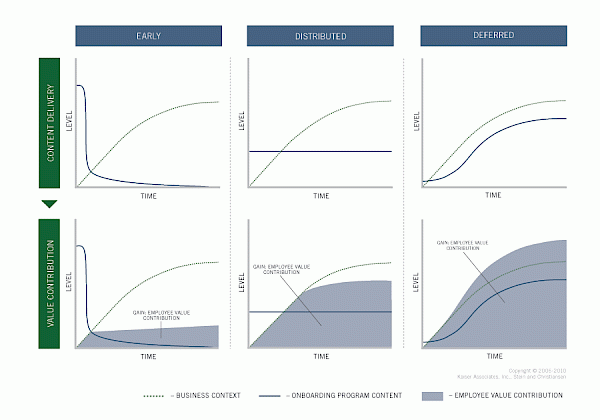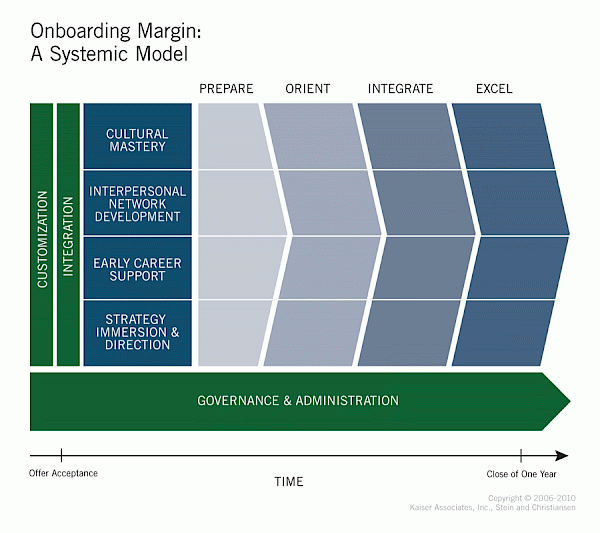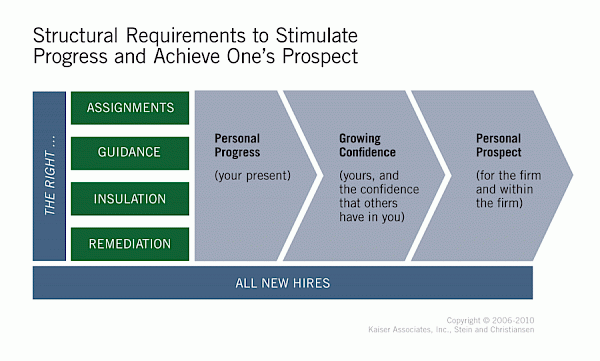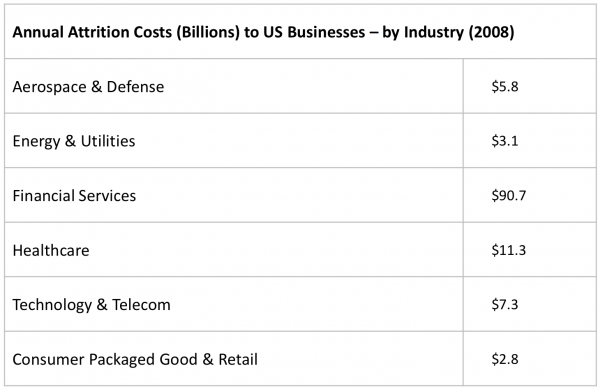Onboarding Margin™
We hope that we provide you with an exciting discovery: you soon determine that your company has been leaving a great source of competitive advantage, enterprise growth and profit on the table, due to a number of old and tired ideas on how your firm brings in new employees to your organization.
Think about this …with annual attrition rates ranging from 8% to 15%, companies are effectively turning over up to 60% of their entire workforce every 4 years, or up to 75% every 5 years. Turnover is expensive, productivity potential is insufficiently realized, and the unique strategic opportunity to renew the enterprise with this fresh blood – with a clean slate – is terribly under leveraged because the onboarding process is hardly considered, and simply under-developed and under-managed. Annual recruiting, intake and attrition have become the norm and are expensive; yet company leadership has not recognized the opportunity that this investment represents – and they are not yet aware of the management techniques or system that can enable them to take advantage of it.
What is Onboarding?
We like to begin the discussion with what Onboarding is NOT. Onboarding is NOT the initial orientation and forms processing that most companies provide new hires in the first days of entry. Onboarding is NOT a piece of software.
Onboarding IS the collective experience that new hires and their managers have in the entire course of their first year (if they make it that long) of employment. Their interpretation of this entire experience determines their behavior, their productivity, their potential, and the decisions that they make that ultimately result in a net benefit or net drain for the enterprise.
The Clash may have put it best:
So you’ve got to let me know. Should I stay or should I go?
And if I stay will there be trouble? And if I go will there be double?
And in our version, we add (although it is hard to keep the tune):
And if I stay, how well prepared will I be? And how willing am I to give to the enterprise?
The net benefit or net drain that is determined by the new hire onboarding experiences is the New Hire Contribution (NHC). The enterprise’s job is to maximize it. If done correctly, it is win-win for all parties. It is an improved compact, an enhanced commitment, between the new hire and the enterprise to give each other the best they have to offer.
What is the Onboarding experience?
You can’t begin from the enterprise’s point of view. This is one of the reasons why typical orientation programs have such limited impact. You need to start with the new hire and the hiring manager’s point of view. When you start here, you examine all of the meaningful “firsts” (View Key Firsts List) and consider how they are interpreted (the take-aways) over the course of the new hire’s first year. These takeaways, along with the firsts that are expected by new hires and never realized, ultimately determine the New Hire Contribution. It is evident that this long list of firsts extends far beyond the typical orientation programs. The meaty part, is NOT filling out forms, reading the mission statement or compliance documents, getting a phone line, email address or other tools of the trade. Those are necessities that are no more or less impactful than filling the car up for gas before you head into work; necessities, but not differentiators or inspiration.
Onboarding Margin is an approach that empowers an organization to realize the benefits of quicker ‘time to productivity’, increases in the ‘level of productivity’, reduces levels of attrition, improvements in attrition mix (the mix of regrettable and non-regrettable attrition), reductions in operating costs, and far greater execution against the strategic and business plans. Together we term these benefits the Onboarding Margin because this collective gain in performance will have direct impact on your bottom line profit, your future profit potential, and shareholder return.
To help put this in greater perspective, annually attrition alone costs US companies huge dollars, as outlined by the following figures:
So what is Successful Onboarding?
Successful Onboarding is a systemic and design-driven approach to integrate new hires into an organization with great positive impact.
It is a process that focuses on effectively transferring company, organization, team and role specific knowledge, as well as providing instructive insight into the organization’s culture and strategic direction, building valuable relationships, providing a welcoming, and appropriately customized experience for the new employee (meeting their needs (think Maslow) and the needs of the enterprise), and enabling new hires to discover and properly consider career path, career development and provide support to drive personal progress.
Successful Onboarding begins at point of offer acceptance and is supported by multiple stakeholders and role players during the entire term of a new hire’s first year – and confidence that it (employment) will last a lot longer.
Successful Onboarding is strategic onboarding. Successful Onboarding is an improved compact between the new hire and the enterprise that has far greater value – a commitment to give each other the best they have to offer. It is a process by which a workforce is reconstituted, excited and enrolled to align with the firm’s particular business strategy. The outcome creates competitive advantage and results in a far more rewarding picture for all stakeholders.
Copyright © Stein and Christiansen
What is broken?
You need to deploy a system that addresses the piece-parts of the New Hire Contribution (NHC) = [Capability + Context + Connectedness + Drive]. We like to think of this system as a multiplier that materially improves these four factors (Capability, Context, Connectedness and Drive). A weak system can actually drag down your NHC and a strong one can make it swell. The beauty of it all is that this new system actually improves the terms of the compact, (i.e., the relationship) that you have with your new hires. This improved employer-employee compact is what ultimately drives greater personal and enterprise performance – Successful Onboarding makes the case for it, and shows you how.
In addition to the previously noted fact that the experience is under-designed, under-developed and under-managed, the process itself is backwards. At most companies, the onboarding content and experiences that are designed into the new hire onboarding experience are solely delivered the first day or first week upon arrival. One problem, for starters, is that it is “drinking out of a fire hose” and the new hire can’t keep it in. Your new hires, besides getting too much, too fast, are getting it too soon.
 They have no context that would otherwise allow them to absorb properly and completely and put it to all to work. In developing the Onboarding Margin model we looked at three approaches to delivery in an onboarding system – early delivery, distributed delivery and deferred delivery. The differences between the three in ultimate NHC is dramatic.
They have no context that would otherwise allow them to absorb properly and completely and put it to all to work. In developing the Onboarding Margin model we looked at three approaches to delivery in an onboarding system – early delivery, distributed delivery and deferred delivery. The differences between the three in ultimate NHC is dramatic.
The Onboarding Margin requires success with program content along four key pillars: Cultural Mastery; Interpersonal Network Development; Early Career Support; and Strategy Immersion and Direction.
 The last two of these serve as the power pillars – i.e., they have the opportunity to drive the greatest impact. When you deliver these in a systemic fashion (integrated with the human capital and business processes and daily activities) against the full term of a year, you have an effective program. But – and this is a critical but – there is no cookie cutter formula; there is no single set of best practices that simply apply to every organization. The real opportunity to achieve the Onboarding Margin comes from a thoughtful examination of the circumstances of your business, your resources, and the specific objectives sought by leadership for the business – which together informs which practices, the specific design requirements and the underlying content, are necessary to realize the Onboarding Margin.
The last two of these serve as the power pillars – i.e., they have the opportunity to drive the greatest impact. When you deliver these in a systemic fashion (integrated with the human capital and business processes and daily activities) against the full term of a year, you have an effective program. But – and this is a critical but – there is no cookie cutter formula; there is no single set of best practices that simply apply to every organization. The real opportunity to achieve the Onboarding Margin comes from a thoughtful examination of the circumstances of your business, your resources, and the specific objectives sought by leadership for the business – which together informs which practices, the specific design requirements and the underlying content, are necessary to realize the Onboarding Margin.
 At the individual new hire level, the system needs to inform, entice and support the new hire so that they experience personal progress. Without the emotional reward of continued progress – as measured by the new hire and recognized by the new hire’s peers and managers – the actual prospect rapidly diminishes to the detriment of the employee and the enterprise.
At the individual new hire level, the system needs to inform, entice and support the new hire so that they experience personal progress. Without the emotional reward of continued progress – as measured by the new hire and recognized by the new hire’s peers and managers – the actual prospect rapidly diminishes to the detriment of the employee and the enterprise.
We invite you to learn more about the potential of the Onboarding Margin, and the specific how-to’s, by spending time with our materials, our book, our community of like-minded change agents, and with us.

